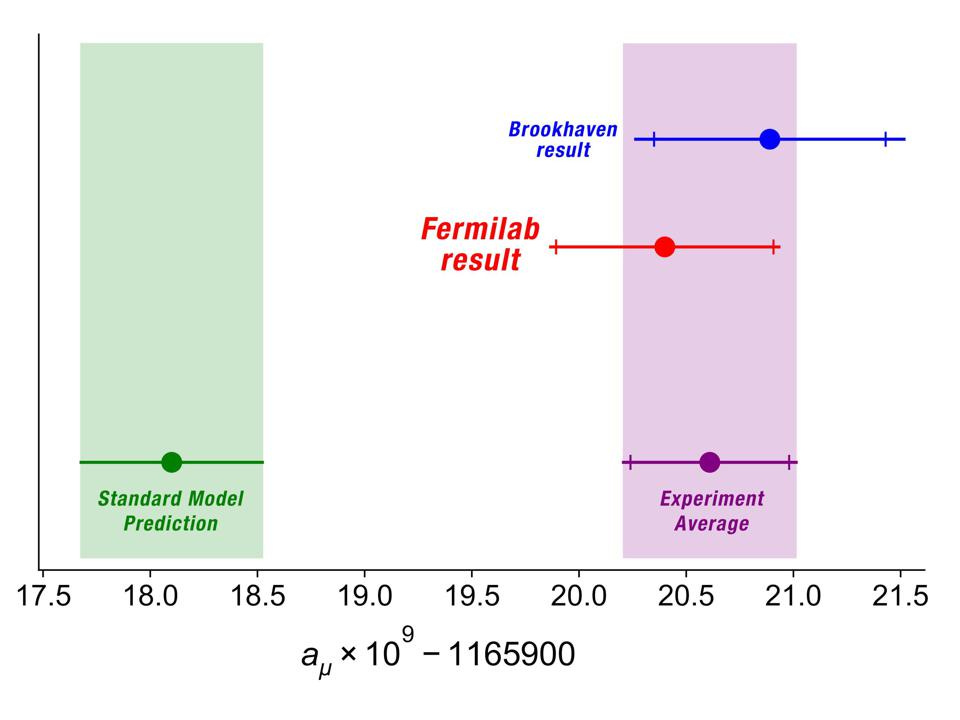Hey,
As of this morning we can travel within counties so a little hope is on the horizon 🌅
Anyway, C’mere to me…
Bunch of videos to share this week, just a better medium to explain bits in this case 📺
PhysicsDiscrepancy between Experiment and Theory ⚛
A pretty remarkable result was released to the physics world at the end of last week, let’s talk about it. I think it’s really cool, albeit I barely understand it either.
Essentially, extremely simplified, there are particles call Muons (similar to electrons but 200x heavier) and how they behave in a magnetic field, specifically their ‘wobble’, can be ultra-precisely calculated and this number is called the g-factor.
Back in 2001, an experiment was conducted at the Brookhaven National Laboratory, on Long Island NY, and this seemed to show that the Muon behaved differently to the Standard Model - a particle physics theory describing three of the four known fundamental forces (gravity being the other).
The g-factor was not as predicted.
For the last 20 years, they have been working on and preparing for another go in the Fermi National Accelerator Laboratory, near Chicago. This time though with significantly more precision, to establish whether this deviation was merely just the result of errors and uncertainties in the experiment or some new unknown phenomenon.
“In its first year of operation, in 2018, the Fermilab experiment collected more data than all prior muon g-factor experiments combined. With more than 200 scientists from 35 institutions in seven countries, the Muon g-2 collaboration has now finished analyzing the motion of more than 8 billion muons from that first run.
Data analysis on the second and third runs of the experiment is under way, the fourth run is ongoing, and a fifth run is planned. Combining the results from all five runs will give scientists an even more precise measurement of the muon’s wobble, revealing with greater certainty whether new physics is hiding within the quantum foam.” - Fermilab News

It’s important to appreciate just how long the data analysis and validation of calculations like this take.
“To ensure the objectivity of the analyses, several analysis teams are working in parallel and independently of one another. The experiment is also using blinding techniques similar to those employed in clinical trials.
First, the analysis teams relate the frequencies they measure to a clock whose pace has been slightly altered -- and is now running too fast or too slow. A clock on the wall of this kind, for instance, would tick 60 times, but the time elapsed would be slightly more or less than one minute. Only two people beyond the experiment know the factor by which the clock has been adjusted -- in the experiment, this corresponds to a particular signal on the frequency measuring devices. Only when the relative results of the individual teams are consistent with each other (known as "relative unblinding") is this factor announced and can then be factored into the calculation. ”
(read more - Science Daily)
As you can see from the graph above, neither result agrees with the Standard Model.
Now, these results are not certain enough to be a refute of the Standard Model (yet), as the departure of the two combined experiments from the theory is 4.2σ (standard deviations) and Physicists only consider it a ‘discovery’ when the probability that the result was a fluke is 5σ1 or less than 0.00005 %
What’s unusual is that this deviation from the Standard Model mean this isn’t something we’ve theorised or that scientists expected.
Unlike say, the discovery of the Higgs Boson in 2012, which was theorised fifty years earlier and then finally proven by experiment, in this case, scientists have no idea what is causing the discrepancy.
So this could be an experimental error (although the chances of that are about 1 in 40,000), but it also could be some fifth fundamental force… they actually don’t know yet, and that’s exciting 👀. There are also computer modelling calculations underway too using Lattice QCD, the latest of which tend to agree with the experimental data rather than the theoretical data which is also compelling.
Here are a few resources for those who want to read up in more detail;
There is an extensive article by Forbes, definitely worth a read.
This is the detailed press release on the Fermilab Gov Site.
And this video by Fermilab is also a good explanation.
YouTuber Dianna Cowern, know as Physics Girl, also put up a really simple but great video where she just tries to explain it to her small production team (who aren’t scientists) and it’s a fab conversation to listen to if you’re interested.
Mad Stuff
Pong 🏓🐒
Another time we can talk about Neuralink and what they’re up to, but they also released this video on Friday of a Monkey playing the arcade game Pong just with its mind…
This video offers a brief explanation too, so is worth a quick watch.
Smile 😊

for tech people today
Saved 📷
Think 🌊
Villains would win a lot more often if they’d just set the bomb timer 1 second shorter
That’s all 🤙🏽
Feel free to reply to this email ↩️
I love to hear your thoughts, if you ever want to get in touch you can email guyb@cmeretome.ie or simply reply to any of these emails! And if you ever stumble across a cool story/link you think is worth sharing — submit it here.
Please Share 📩🤝🏼
If you enjoy reading this every week I’m sure your friends would too.
Consider Supporting ☕
If you like my content and want to give back in the simplest way possible, please consider buying me a coffee.
Thank you so much ❤
Guy
Disclaimer.
https://news.fnal.gov/2021/04/first-results-from-fermilabs-muon-g-2-experiment-strengthen-evidence-of-new-physics/









